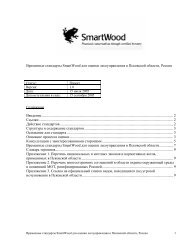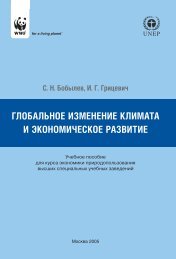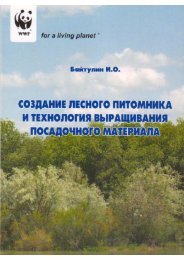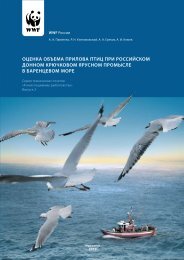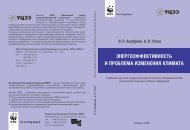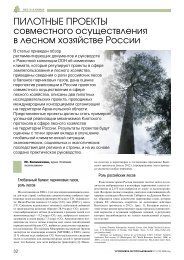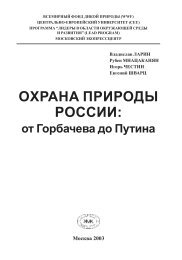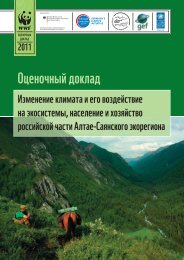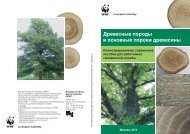Russia-China Timber Trade_cover.jpg
Russia-China Timber Trade_cover.jpg
Russia-China Timber Trade_cover.jpg
You also want an ePaper? Increase the reach of your titles
YUMPU automatically turns print PDFs into web optimized ePapers that Google loves.
Taking into consideration the major actors mentioned above, <strong>Russia</strong>n timber export to <strong>China</strong> follows two majortimber chain models:I. Direct chain: Commercial Harvester → ImporterThis is the simplest and most transparent scheme making it easier to control production costs, export volumes,and revenue generation. This scheme is most common for large timber harvesters and processors and pulpand paper companies with long-term timber leases. Usually, it involves export of softwood in Eastern Siberiaand the northern areas of the RFE (Khabarovskiy Kray, Amurskaya Oblast). Except for companies in distanthinterlands, many large harvesters or producers are also registered as exporters with relevant licenses fromthe <strong>Russia</strong>n Ministry of Economic Development and <strong>Trade</strong>. They usually lease large forest areas and contributesignificantly to the economic and social infrastructure of forest communities. These harvesters can buy illegallyharvested timber from elsewhere, but they also admit to illegal logging on their forest lands. Their main infringementsare related to hiding actual volumes of harvesting and processing to keep production costs low and tominimize taxation. This is estimated at 10% to 30% of total export revenues. Most regional and federal authoritiesfavour these large harvesters, while insisting that they develop processing as a pre-condition for leasingnew forest lands. Since links between transporters and importers are rather common, we have chosen not tofocus on this chain in this report.II. Intermediary Chain: Harvester → Intermediary → ImporterIntermediaries are very numerous and play an influential role in the <strong>Russia</strong>n-Chinese timber trade, especially inborder areas. While large harvesting and processing companies export the bulk of timber, intermediaries, includingnumerous private persons and small firms, also play an influential role, particularly for smaller timbercompanies. Of course, such intermediaries can play positive roles in the market. They can consolidate lots andassortments and make links with consumers, which is important to expand markets for sawnwood. However, todate, most intermediaries have sought quick profits at the expense of long-term sustainability. Income for intermediariesgreatly depends on the ability to gain access to sorting, storing and transport infrastructure. Withproper infrastructure, intermediaries can facilitate transfer from the log yard to the export point. Without necessaryfacilities, they contract outside carriers. Intermediaries play a critical role in laundering illegally harvestedtimber. By so doing, intermediaries can retain from one-third to two-thirds of the final revenues from export. Inmany cases, this timber is impossible to trace. These intermediaries are necessary when:• Short-term or one-time lease loggers, principally small companies or private persons, have no relevantexport infrastructure (to sort, store, transport, develop links with foreign importers, follow proper export formalities,etc.). These loggers will sell their timber to the nearest larger, more experienced, better-known company,or ask the company to serve as an export agent.• There is a different type of intermediary from the type that can offer infrastructure services. This intermediaryis a foreign trade association and it is still commonly used in remote areas. The harvester focuses on timberharvesting, while the association studies the export market, sets prices, and seeks out reliable trading partners.These traders also provide logistical support. <strong>Trade</strong>rs at these associations often enter into long-term supplycontracts with commercial harvesters and may use the harvester’s available infrastructure.• Intermediaries can also assist with rudimentary processing, which serves as a means to avoid official regionaldemands on the development of wood processing or to legalize illegally harvested timber.• Illegal loggers can only sell illegally harvested timber only to other commercial harvesters, traders or processors,who legalize it under the guise of logging tickets or rudimentary processing. The carrier can also exportillegally harvested timber by misclassifying or underdeclaring volume, or by bribing customs officials and smuggling.Table 9 shows the summarized data on exports of rare and valuable species from the RFE to <strong>China</strong> for the RFEprovinces.Private intermediaries and Chinese firms with both legal and illegal Chinese investment play a considerablerole in the turnover and export of rare coniferous and valuable hardwood, especially in border areas adjacent to<strong>China</strong>. Rudimentary processing of such species, in most cases, is a way to avoid customs export controls. Thisis of great concern with regard to trading companies or processing companies with Chinese investment. Asidefrom stimulating illegal logging of rare and valuable tree species, such rudimentary processing does not bringeconomic or social benefits to timber-dependent communities.31



